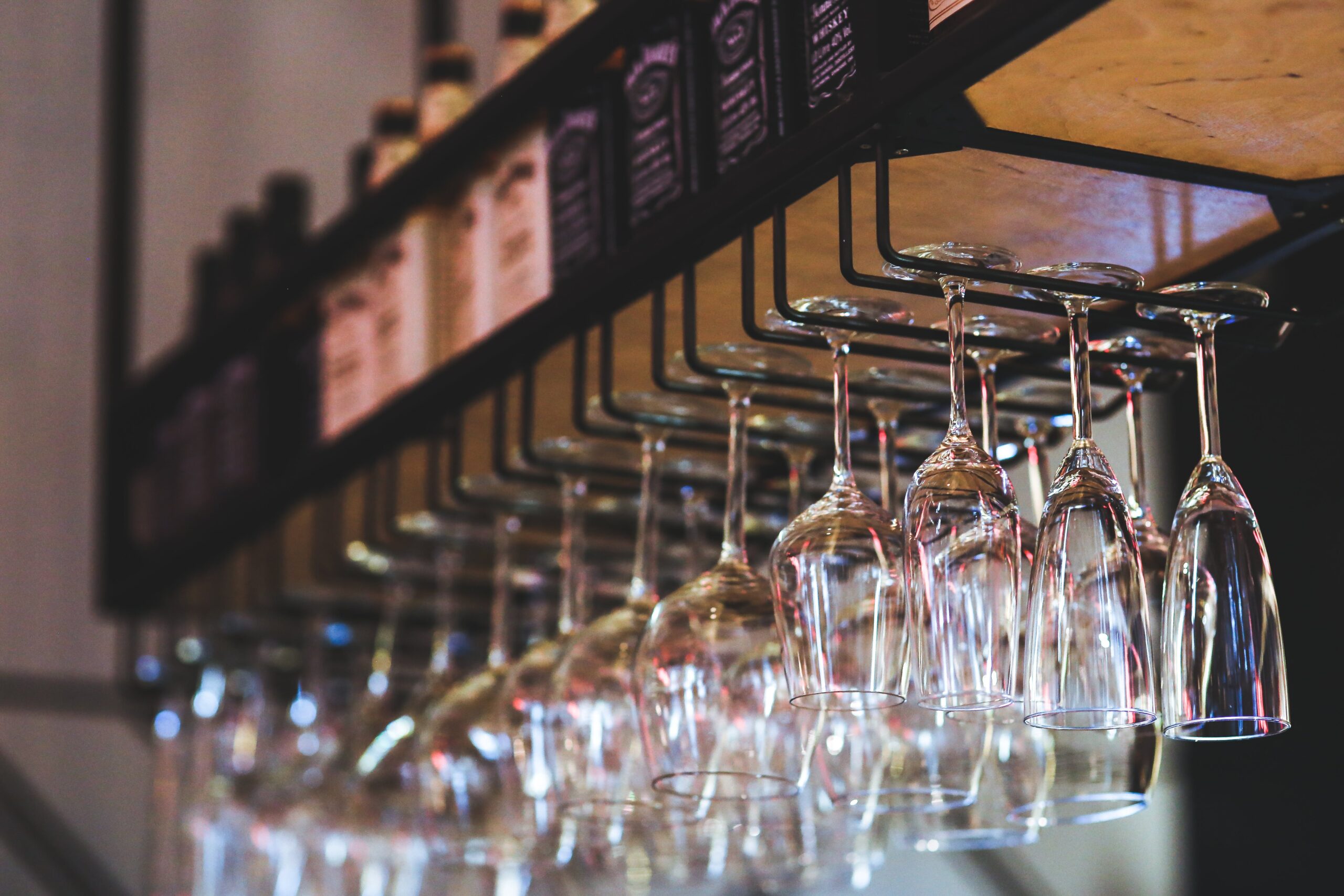Wine Glasses Explained. It’s Not Just A Fancy Glass
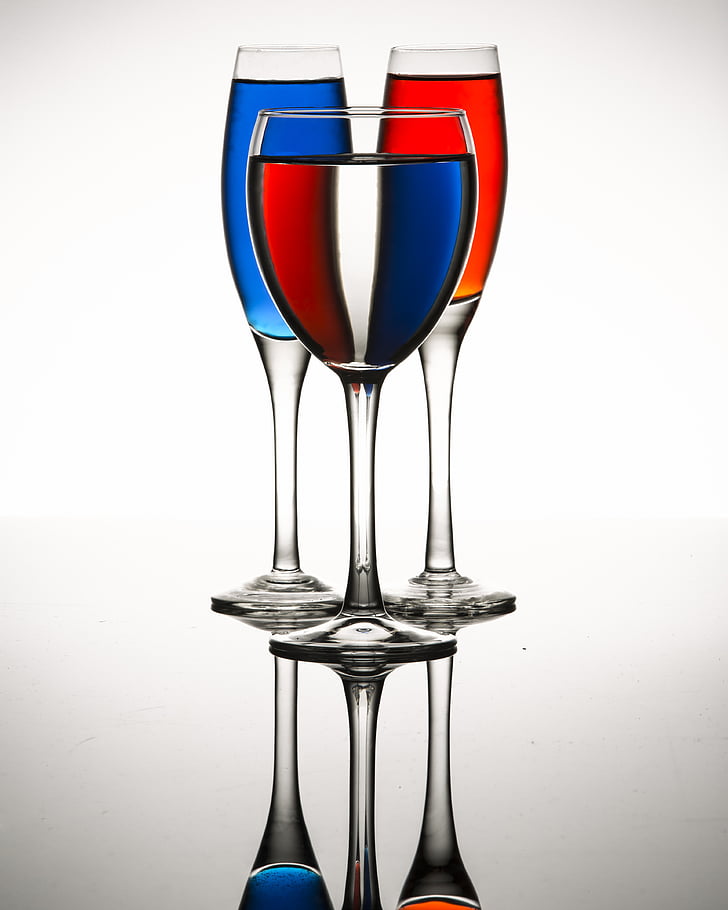
The vessel from which we sip plays a crucial role in this expedition of the senses. Wine glasses, often overlooked as mere receptacles, are in fact, integral to the appreciation of this ancient beverage and the characteristics of each varietal. It becomes evident that it’s not just about what’s in the glass; the glass itself is a key player in the symphony of flavors and aromas that can be experienced with every pour.
| Wine Type | Glass Shape | Characteristics |
| Red Bordeaux | Tall with a broad bowl and a slightly tapered top. | Enhances aeration for bold red wines like Cabernet Sauvignon and Merlot. |
| Red Burgundy | Wider bowl with a larger opening | Allows delicate aromas of Pinot Noir to develop and be appreciated. |
| Chardonnay | Wide bowl with a slightly tapered top. | Enhances the buttery and oaky notes of Chardonnay while directing the wine to the tip of the tongue. |
| Sauvignon Blanc | Tall and narrow with a smaller bowl. | Preserve the crispness and intensity of the wine, focusing on the nose. |
| Riesling | Tall and narrow with a slightly tapered top. | Directs the flow of the wine to the tip of the tongue, emphasizing the sweetness of Riesling. |
| Champagne/Sparkling | Tall and narrow flute or a wider tulip-shaped glass. | Maintains the effervescence and allows the aromas to concentrate. |
| Rosé | Similar to a standard white wine glass but slightly smaller. | Enhances the floral and fruity notes of rosé wines. |
| Dessert Wine | Small with a narrow bowl. | Concentrates the rich, sweet flavors of dessert wines. |
Red Bordeaux
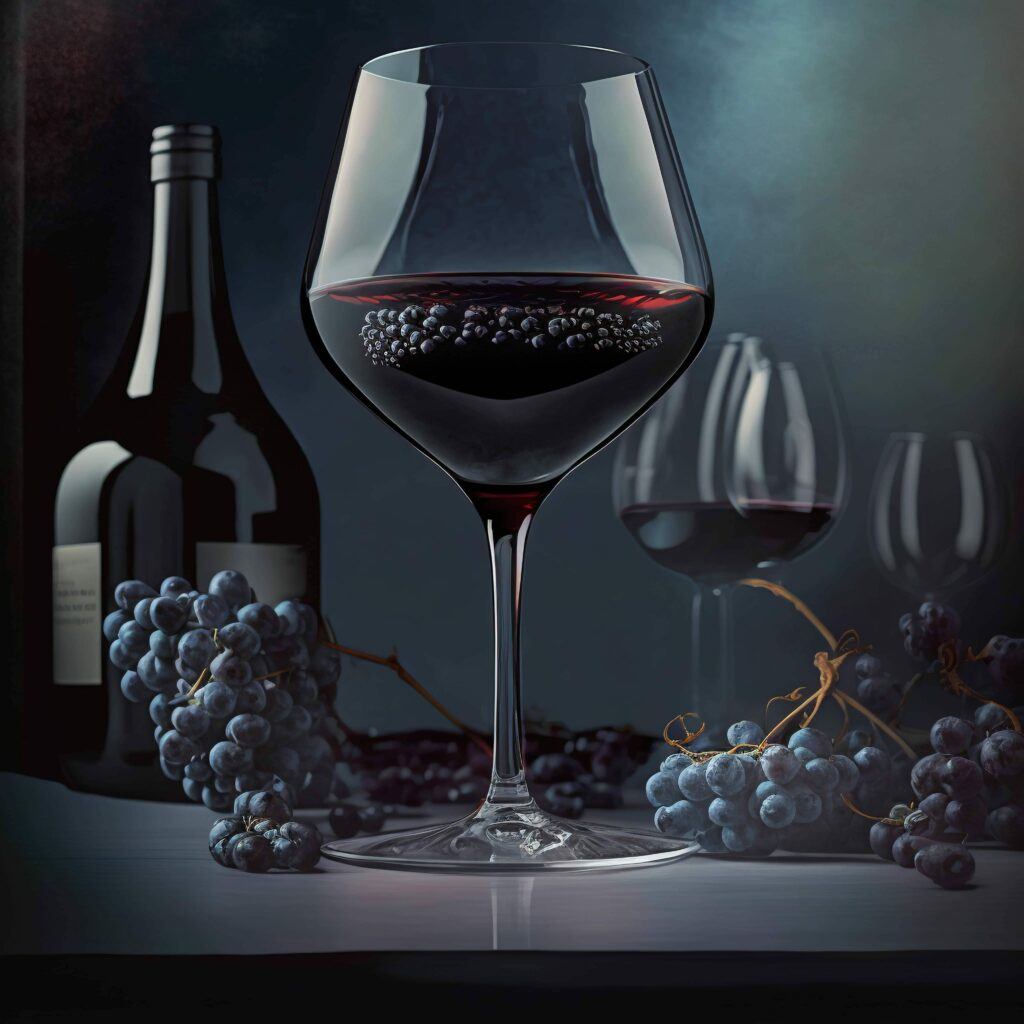
The design of a red Bordeaux glass, characterized by its tall, broad bowl and slightly tapered top, serves specific purposes in enhancing the overall experience of drinking red Bordeaux wines, as well as other bold red wines like Cabernet Sauvignon and Merlot.
Glass Shape: Tall with a broad bowl and a slightly tapered top.
Aeration and Oxidation: The broad bowl provides a large surface area for the wine to come into contact with air.
This increased exposure to air helps the wine to “breathe” and undergo aeration, allowing the wine to open up and release its aromas and flavors.
Tannin Management: Red Bordeaux wines, especially those with a higher tannin content, can benefit from a slightly tapered top.
Red Bordeaux wines, especially those with a higher tannin content, can benefit from a slightly tapered top.
The tapering concentrates the aromas towards the nose while mitigating the perception of harsh tannins, making the wine smoother on the palate.
Temperature Control: The shape of the glass helps in maintaining the appropriate temperature for serving red Bordeaux wines.
The broader bowl allows for a larger volume of wine, which is beneficial for red wines that are typically served at slightly warmer temperatures than whites.
Flavor Concentration: The tapered top of the glass directs the wine to the back of the mouth, where the perception of bitterness is reduced, emphasizing the fruit-forward and complex characteristics of the wine.
Red Burgundy
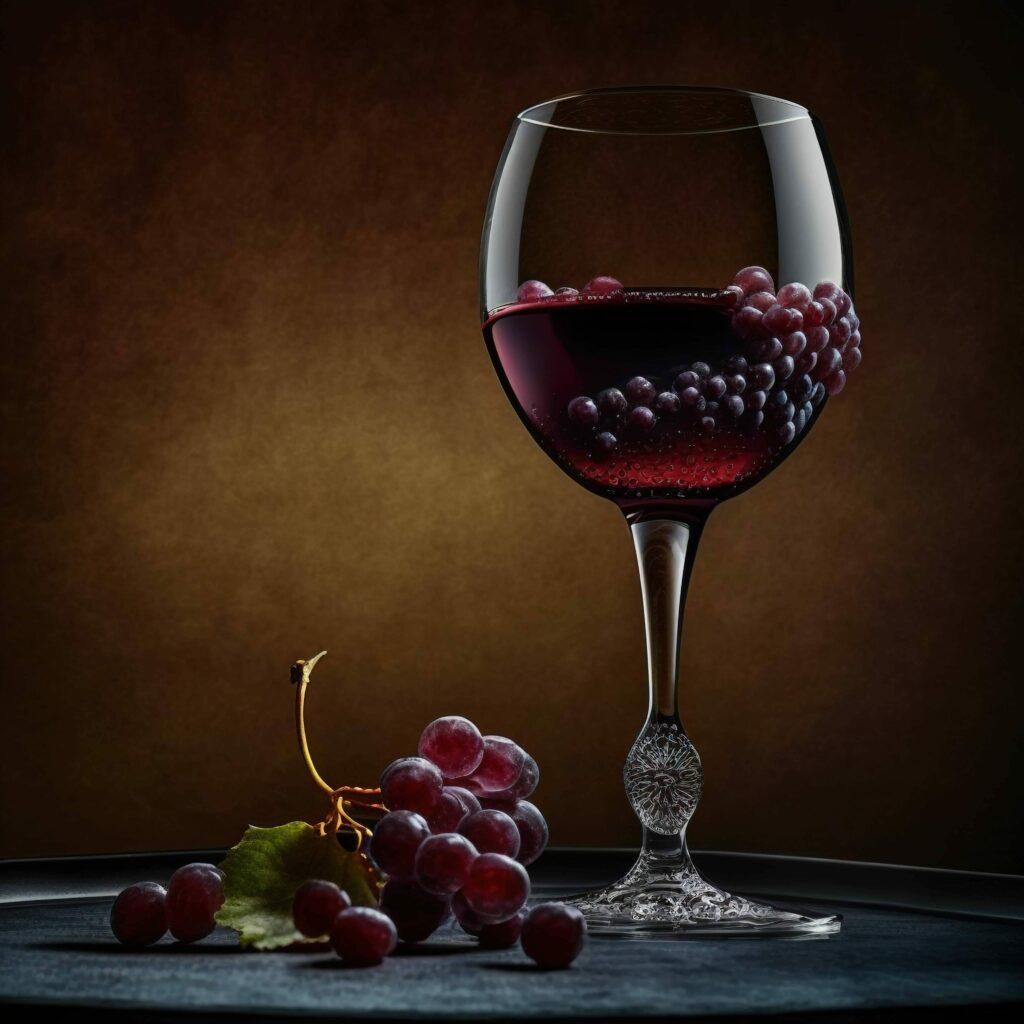
The wider bowl with a larger opening of a red Burgundy glass is purposefully designed to complement the unique characteristics of Pinot Noir-based wines from the Burgundy region. Pinot Noir is known for its delicate aromas and nuanced flavors, and the generous bowl allows for maximum aeration. This increased exposure to air facilitates the development of the wine’s intricate bouquet, allowing subtle notes to unfold more fully. The larger opening also allows the wine to gracefully flow onto the palate, promoting a smoother and more expansive tasting experience. By optimizing the aeration process and accommodating the delicate nature of Pinot Noir, the red Burgundy glass enhances the overall enjoyment of these sophisticated and complex wines.
Glass Shape: Wider bowl with a larger opening.
Aeration and Development of Aromas: Pinot Noir, the predominant grape in red Burgundy wines, boasts delicate and complex aromas.
The wider bowl provides a larger surface area, allowing the wine to come into more contact with air. This aeration process facilitates the gradual unfolding and development of the wine’s intricate bouquet.
Expression of Nuanced Flavors: The larger opening of the glass allows for the wine to elegantly spread across the palate, ensuring a broader and smoother delivery of flavors.
It permits the drinker to fully experience the wine’s subtle and nuanced flavors, creating a more comprehensive and enjoyable tasting experience.
This design aspect elevates the overall sensory experience by allowing the wine to reveal its layers of flavors and textures more distinctly.
Enhanced Texture and Sensory Experience: The wider bowl contributes to a gentler interaction between the wine and the mouth, promoting a smoother texture on the palate.
Chardonnay
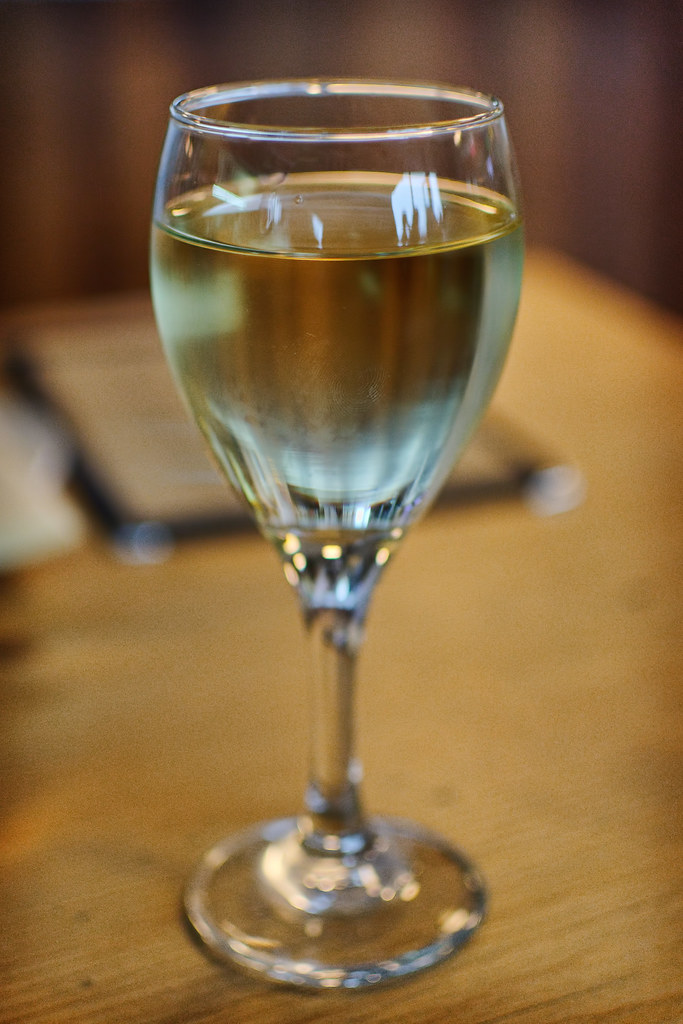
The design of a Chardonnay glass with a wide bowl and a slightly tapered top serves to accentuate the unique characteristics of the wines. Chardonnay often exhibits complex aromas, including notes of butter, oak, and various fruits. The wide bowl allows for increased surface area, promoting aeration that helps these diverse aromas to develop and become more pronounced. The slightly tapered top concentrates these aromas, directing them towards the nose, where they can be better appreciated and savored.
Glass Shape: Wide bowl with a slightly tapered top.
Enhancing Aromas and Flavors: Chardonnay often exhibits complex aromas, including notes of butter, oak, and various fruits.
The wide bowl allows for increased surface area, promoting aeration that helps these diverse aromas to develop and become more pronounced.
The slightly tapered top concentrates these aromas, directing them towards the nose, where they can be better appreciated and savored.
Balancing Flavors on the Palate: The tapered top also aids in directing the wine to the tip of the tongue, where the taste buds perceive sweetness.
By guiding the wine to this part of the palate, the glass assists in emphasizing the fruitiness and acidity of the Chardonnay while toning down any excessive bitterness.
Temperature Control: The wide bowl allows enough room for the wine to be swirled, helping to release its aromas and flavors while maintaining the wine at an appropriate temperature.
Chardonnay is often served slightly chilled, and the wider bowl accommodates the needed space for chilling without altering the wine’s temperature too rapidly.
Sauvignon Blanc
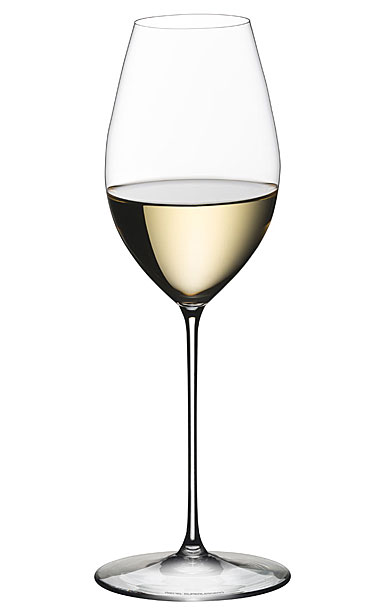
The Sauvignon Blanc glass is distinguished by its tall and narrow design with a smaller bowl, strategically crafted to amplify the unique traits of Sauvignon Blanc wines. Its tall stature aids in preserving the wine’s vibrant aromatics, capturing and concentrating the zesty notes of citrus and herbs inherent in Sauvignon Blanc. The smaller bowl minimizes exposure to air, ensuring that the wine’s intense and crisp flavors remain focused, allowing for a refreshing tasting experience. Additionally, this shape directs the wine’s aromas toward the nose, emphasizing the wine’s aromatic complexity while accentuating its bright acidity on the palate. Overall, the Sauvignon Blanc glass shape aims to maintain the wine’s aromatic intensity, highlight its refreshing qualities, and deliver a nuanced tasting sensation for enthusiasts of this lively varietal.
Glass Shape: Tall and narrow with a smaller bowl.
Preserving Aromatics and Crispness: Sauvignon Blanc is known for its vibrant and zesty aromas, often showcasing notes of citrus, herbs, and grass.
The tall and narrow shape of the glass helps in trapping and concentrating these aromatic compounds, preserving the wine’s lively and fresh aromas.
Maintaining Intensity and Focus: The smaller bowl minimizes the surface area exposed to air, which helps retain the wine’s intensity and concentration of flavors.
This design ensures that the aromatic qualities and vibrant acidity of Sauvignon Blanc remain prominent, offering a focused and crisp tasting experience.
Directing Aromas and Flavors: The narrowness of the glass guides the wine toward the nose, allowing the drinker to fully appreciate the aromatic complexity of Sauvignon Blanc.
It also directs the wine to specific parts of the palate, emphasizing the wine’s acidity and accentuating its refreshing qualities.
Temperature Regulation: The smaller bowl aids in maintaining the wine at a cooler temperature by reducing the wine’s exposure to air, ensuring that the refreshing and crisp attributes associated with Sauvignon Blanc are preserved throughout consumption.
Riesling

The design of a tall and narrow glass with a slightly tapered top for Riesling wines is tailored to enhance the distinctive characteristics of this varietal in several ways. The taller shape allows the wine to be poured in a way that directs its aromas upward, intensifying the perception of the wine’s floral and fruity notes. The narrow design helps in concentrating these delicate aromatics towards the drinker’s nose, ensuring an aromatic experience that highlights Riesling’s nuanced bouquet. Additionally, the slight tapering at the top of the glass facilitates a directed flow of the wine to the tip of the tongue, emphasizing the varietal’s sweetness while balancing its natural acidity. This glass shape ultimately aims to maximize the expression of Riesling’s fragrant profile and sweet characteristics, providing an elevated tasting experience for enthusiasts of this renowned white wine.
Glass Shape: Tall and narrow with a slightly tapered top.
Aroma Concentration: The tall and narrow shape concentrates floral and fruity aromas towards the top, intensifying their expression.
Slight tapering further enhances the concentration of delicate aromatics.
Enhanced Aromatic Experience: Concentrated aromas are more pronounced, offering a richer olfactory experience.
Allows for a better appreciation of Riesling’s nuanced bouquet.
Flavor Emphasis and Balance: Directs the wine to the tip of the tongue, highlighting its inherent sweetness.
Balances the wine’s natural acidity, emphasizing the vibrant and fruity flavors.
Optimized Sensory Enjoyment: Enhances the overall enjoyment of Riesling by accentuating its aromatic complexity and balance between sweetness and acidity.
Champagne/Sparkling Wine
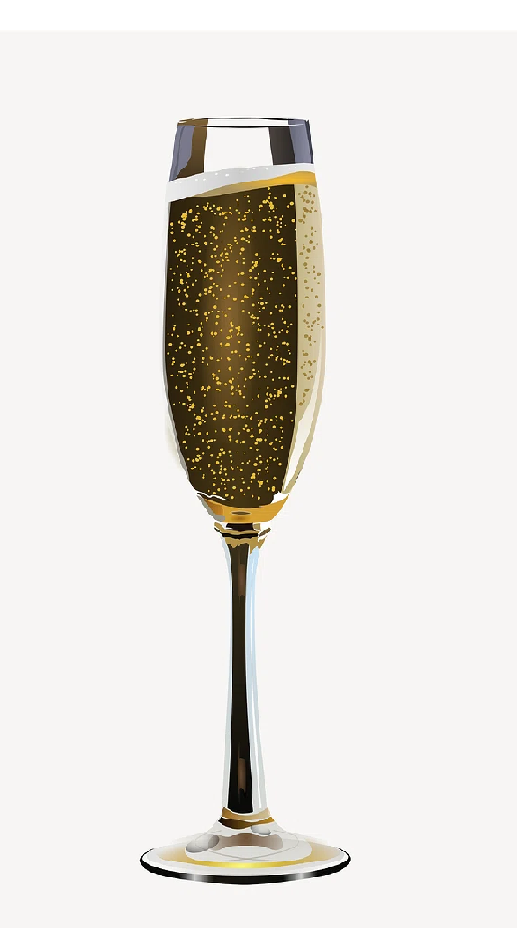
The design of a tall and narrow flute or a wider tulip glass for Champagne and Sparkling Wine serves specific purposes that enhance the overall tasting experience. Firstly, the tall and narrow shape of a flute minimizes the wine’s exposure to air, preserving its effervescence and ensuring that the bubbles are maintained for a longer time. This design helps to concentrate the bubbles, allowing them to rise elegantly and consistently from the bottom of the glass, showcasing the wine’s lively and persistent effervescence. Alternatively, the wider tulip-shaped glass offers a similar benefit by maintaining effervescence while providing a slightly broader bowl, allowing for a more pronounced development of the wine’s aromas. Both designs aim to concentrate the delicate effervescence and aromatic qualities of Champagne and Sparkling Wine, ensuring a more captivating and enjoyable sensory experience for the drinker.
Glass Shape: Tall and narrow flute or a wider tulip-shaped glass.
Effervescence Preservation: The tall and narrow flute design minimizes exposure to air, preserving the wine’s effervescence for longer durations.
Ensures the bubbles remain lively and persistent throughout consumption.
Concentration of Bubbles: The narrow shape concentrates the bubbles, allowing them to rise elegantly and consistently from the base of the glass.
Showcases the wine’s effervescence in a visually appealing manner.
Aromatic Enhancement (for tulip-shaped glasses): Wider bowl in tulip-shaped glasses permits a more pronounced development of aromas.
Enhances the olfactory experience, allowing for a better appreciation of Champagne’s complex bouquet.
Captivating Sensory Experience: Both designs aim to optimize the Champagne drinking experience by highlighting its effervescence and aromatics, ensuring a captivating and enjoyable sensory journey for the imbibers.
The coupe glass is also used for champagne and offers a very different experience. It also flaunts a very different design.
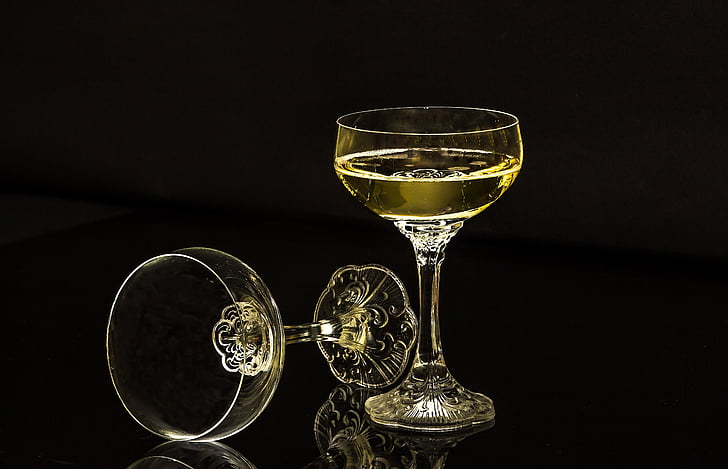
Rosé

A Rosé glass designed akin to a standard white wine glass but slightly smaller serves a specific purpose tailored to accommodate the characteristics of Rosé wines. The resemblance to a white wine glass allows for a similar drinking experience, ensuring that the delicate aromas and nuanced flavors of Rosé are appreciated in a manner reminiscent of white wines. The slight reduction in size aims to concentrate and intensify the floral and fruity notes typically found in Rosé, emphasizing its refreshing qualities. This design strikes a balance between the characteristics of white and red wine glasses, offering an optimal vessel that allows the Rosé’s unique attributes to shine through while maintaining an enjoyable and approachable drinking experience.
Glass Shape: Similar to a standard white wine glass but slightly smaller.
Similarity to White Wine Glass: Resembles a standard white wine glass in shape and design.
Allows for a familiar drinking experience akin to white wines.
Slightly Reduced Size: Smaller in size compared to a standard white wine glass.
Aims to concentrate and intensify the floral and fruity notes inherent in Rosé wines.
Balanced Design: Strikes a balance between white and red wine glass characteristics.
Enhances the refreshing qualities of Rosé while ensuring an approachable and enjoyable drinking experience.
Optimal Vessel for Rosé: Designed to showcase the unique attributes of Rosé wines, emphasizing their delicate aromas and nuanced flavors within a vessel that’s familiar and comfortable for white wine enthusiasts.
Dessert Wine
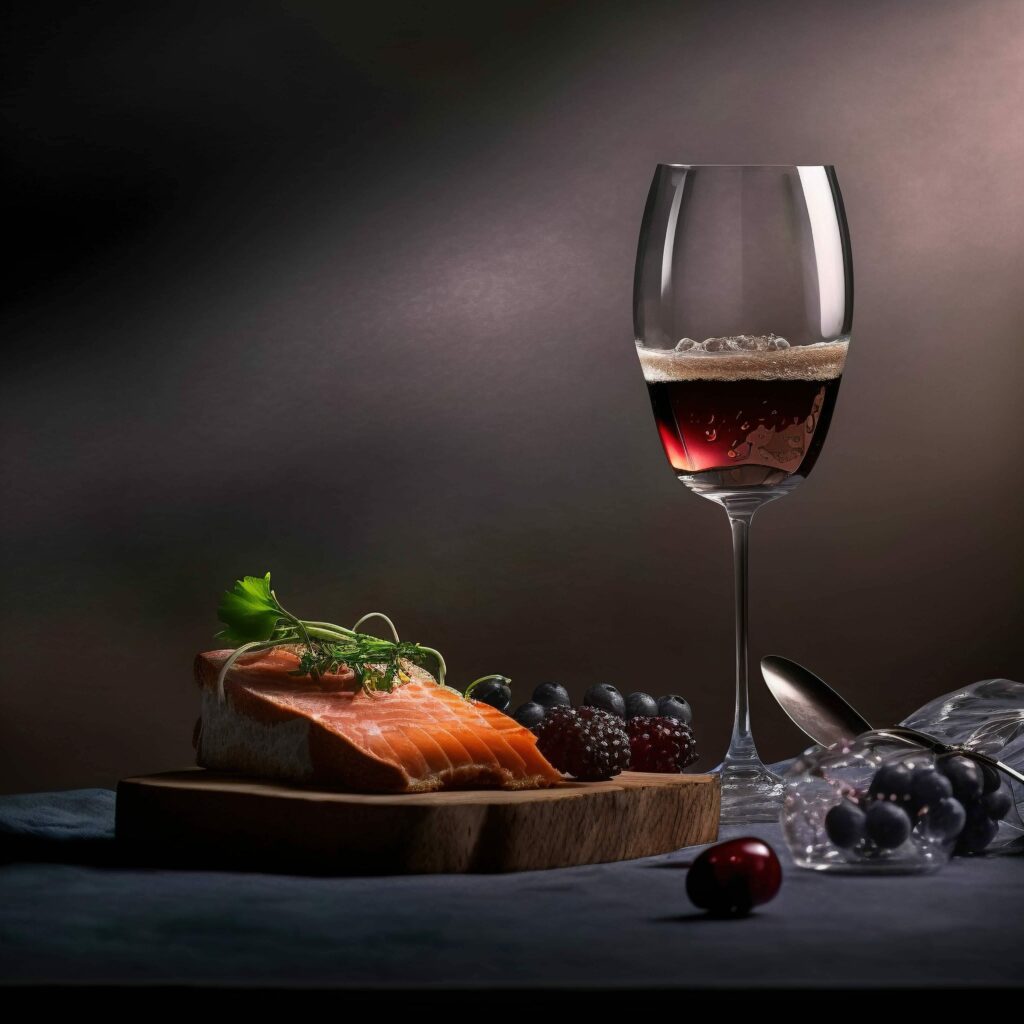
A dessert wine glass characterized by small size and narrow bowl serves specific purposes that cater to the unique qualities of dessert wines. The small size helps to maintain and concentrate the rich, sweet flavors inherent in dessert wines. By limiting the wine’s exposure to air, the narrow bowl helps to preserve the wine’s sweetness and intensity, ensuring that these characteristics are not diluted or dissipated. Additionally, the narrow bowl directs the wine towards the back of the palate, emphasizing its sweetness and allowing for a more indulgent and satisfying tasting experience. Overall, this design optimizes the enjoyment of dessert wines by concentrating on their rich flavors and enhancing their luscious sweetness in a more controlled and immersive manner.
Glass Shape: Small with a narrow bowl.
Preservation of Sweetness: The small size and narrow bowl minimize air exposure, preserving the wine’s rich sweetness.
Ensures that the intense and luscious flavors typical of dessert wines remain concentrated.
Intensity of Flavors: The concentrated shape maintains the intensity of the wine’s flavors without dilution.
Allows for a more immersive tasting experience, emphasizing the wine’s richness.
Emphasis on Palate Positioning: Directs the wine towards the back of the palate, accentuating its sweetness.
Enhances the indulgent and satisfying aspects of tasting dessert wines.
Enhanced Enjoyment: Overall design aims to optimize the experience of dessert wines, intensifying their flavors and sweetness while providing a more controlled and immersive tasting sensation.
Materials Play A Huge Role In Aesthetics
Wine glasses, in their most exquisite forms, transcend mere functionality and become pieces of art. Artisans and designers have embraced the challenge of combining form and function, resulting in glasses that are expressions of creativity. From crystal to hand-blown glass with intricate patterns to stemless glasses with vibrant colors, the world of wine glass design has become a canvas for artistic expression.
Crystal Wine Glass Traits That Set Them Apart From Regular Glassware
Clarity and Brilliance: Crystal wine glasses are known for their exceptional clarity, which allows for a brilliant display of the wine’s color and clarity. The high refractive index of crystal glass gives it a sparkling appearance.
Fine and Thin Construction: Crystal glasses are crafted with precision and are thinner than regular glassware. This delicacy contributes to a more refined drinking experience, allowing the wine to flow smoothly onto the palate.
Enhanced Aromatics and Flavors: The smoother surface of crystal glasses, owing to their finer construction, aids in better aeration of the wine, enhancing its aromas and flavors.
Durability and Resilience: While thinner, crystal glasses are often surprisingly durable due to the addition of minerals like lead oxide. This strength allows for long-lasting glassware.
Elegance and Luxury: Crystal wine glasses are often associated with luxury and elegance due to their exquisite craftsmanship and fine design. They are often used for special occasions or fine dining settings.
Sound and Resonance: When lightly tapped, crystal glasses produce a distinctive and melodic ringing sound due to their unique composition, adding to the sensory experience.
Chemical Composition: Crystal glassware typically contains minerals like lead oxide, which can enhance its clarity, brilliance, and malleability during the crafting process.
Remember, while crystal wine glasses offer these aesthetic and sensory benefits, some may prefer alternatives due to concerns about lead content in certain crystal compositions. Always consider personal preferences and safety aspects when choosing glassware for wine consumption.
Exploring the Distinctive Traits of Glass Wine Glasses
Glass wine glasses, often made from soda-lime glass, possess several distinct traits that differentiate them from crystal glassware.
Sturdiness and Practicality: Glass wine glasses are generally more durable and less prone to chipping or breakage compared to crystal glasses. They are ideal for everyday use and are dishwasher-safe in most cases.
Affordability and Accessibility: Glass wine glasses are more cost-effective and accessible than crystal alternatives. They provide a budget-friendly option for wine enthusiasts without compromising on functionality. This affordability makes them suitable for larger gatherings or regular use without concerns about potential breakage. Their widespread availability in various styles and sizes ensures that wine lovers have an array of options to suit their preferences and occasions without exceeding their budget. Moreover, their practicality extends to their ease of replacement, making them an ideal choice for those seeking reliable and functional glassware for daily use or casual entertaining.
Caring for Your Investment: Proper Maintenance
As we explore the nuances of wine glasses, it’s crucial to acknowledge that these are more than just items in our kitchen cabinets; they are investments in our enjoyment of wine. Caring for them properly ensures that they continue to deliver a flawless drinking experience. Handwashing with mild detergent, gentle drying methods, and avoiding harsh chemicals are fundamental aspects of maintenance. Proper storage, whether in a glass rack or suspended, safeguards against breakage and scratches, preserving the integrity of the glass.
Wine Glass Sets: Curating the Experience
Choosing the right wine glass doesn’t stop at selecting a single piece; it extends to curating a collection that caters to different occasions and wine types. Wine glass sets have become an art form in themselves, with curated selections designed for specific varietals, occasions, and styles. Whether it’s a formal dinner party or a casual gathering with friends, having the right set of glasses adds an extra layer of sophistication to the experience.
Stemless wine glass sets, in particular, have gained popularity for their modern and versatile appeal. These glasses, with a lower center of gravity, are less likely to tip over and are dishwasher safe, making them a practical and stylish choice for everyday use.
Accessories: Expression Of The Ritual
Beyond the glass itself, wine enthusiasts are turning to accessories that further elevate the ritual of wine drinking. From temperature-regulating tools that ensure each sip is enjoyed at the perfect temperature to stylish decanters that enhance the aeration process, these accessories are designed to refine and amplify the sensory elements of wine consumption.
Wine glass charms and markers, often seen as whimsical additions, serve a practical purpose in social gatherings, helping individuals keep track of their glasses. These small but significant details contribute to the overall ambiance and add a touch of personalized style to the occasion.
A Constant Evolution: Trends in 2023
As we navigate the intricacies of wine glasses, it’s essential to recognize that the landscape is ever-evolving. Trends in 2023 reveal a commitment to craftsmanship, sustainability, and innovative designs. Artisanal glassware is making a comeback, with hand-blown creations becoming coveted pieces for wine enthusiasts. Sustainable materials and production methods are gaining traction, reflecting a broader shift towards eco-conscious choices in the wine industry.
Temperature-sensitive glass and smart features are emerging as novel additions, catering to the tech-savvy consumer looking for a seamless integration of technology and tradition. Stemless glasses with unique shapes and specialized designs for different varietals are becoming staples in the world of wine glass trends.
Wine glasses are conduits that enhance the entire drinking experience. The shape, material, and design contribute to the symphony of flavors and aromas that make each sip a moment of pleasure. Whether you’re a seasoned connoisseur or a casual enthusiast, exploring the world of wine glasses adds a layer of sophistication to your appreciation of this timeless beverage. As we raise our glasses to the possibilities of 2023, let each pour be a celebration of taste, style, and the joy of indulging in the finer things in life. Cheers!

